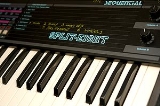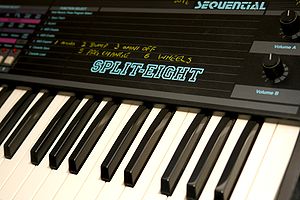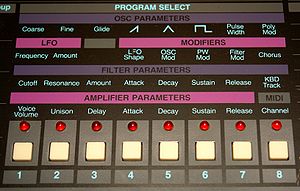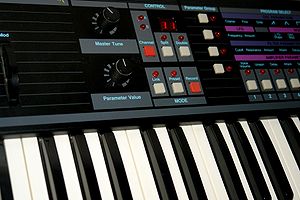
Split-8
Encyclopedia

Polyphony (instrument)
Polyphony Instruments that are not capable of polyphony are monophonic.-Synthesizer:Most of early synthesizers were monophonic musical instruments which can play only one note at a time, and are often called monosynth as opposed to polysynth...
analogue keyboard synthesizer
Analog synthesizer
An analog or analogue synthesizer is a synthesizer that uses analog circuits and analog computer techniques to generate sound electronically. The earliest analog synthesizers in the 1920s and 1930s such as the Trautonium were built with a variety of vacuum-tube and electro-mechanical technologies...
manufactured by Sequential Circuits
Sequential Circuits
Sequential Circuits Inc. was a California-based synthesizer company that was founded in the early 1970s by Dave Smith and sold to Yamaha Corporation in 1987. The company, throughout its lifespan, pioneered many groundbreaking technologies and design principles that are often taken for granted in...
. Built in Japan and going by the alternative name "Pro-8" in some markets, this was one of the last synthesizers produced by the company and was assigned model number 608. It was released in 1985 at a list price of $1,199 (or $1,195; this number varied between advertisements). This and some other Sequential Circuits
Sequential Circuits
Sequential Circuits Inc. was a California-based synthesizer company that was founded in the early 1970s by Dave Smith and sold to Yamaha Corporation in 1987. The company, throughout its lifespan, pioneered many groundbreaking technologies and design principles that are often taken for granted in...
synthesizers (the Six-Trak
Sequential Circuits Six-Trak
The Six-Trak was an analogue synthesizer manufactured by Sequential Circuits in San Jose, California and released in January 1984. It is notable for being one of the first multi-timbral synthesizers, equipped with MIDI and an on-board six-track digital sequencer, hence the name. It was designed as...
, Multi-Trak and MAX) were built around the Curtis Electronics CEM
Curtis CEM
Curtis CEM chips are analog chips used in many synthesizers.Curtis Electromusic Specialties, founded by Doug Curtis , developed a family of signal-processing products for electronic music synthesizers and audio equipment.-SSM and CEM:Chips List...
3394 "synth-on-a-chip" integrated circuit
Integrated circuit
An integrated circuit or monolithic integrated circuit is an electronic circuit manufactured by the patterned diffusion of trace elements into the surface of a thin substrate of semiconductor material...
, and used a Z80 as their central microprocessor
Microprocessor
A microprocessor incorporates the functions of a computer's central processing unit on a single integrated circuit, or at most a few integrated circuits. It is a multipurpose, programmable device that accepts digital data as input, processes it according to instructions stored in its memory, and...
.
Brief Summary of Features
This electronic keyboardElectronic keyboard
An electronic keyboard is an electronic or digital keyboard instrument.The major components of a typical modern electronic keyboard are:...
is an 8-voice polyphonic
Polyphony (instrument)
Polyphony Instruments that are not capable of polyphony are monophonic.-Synthesizer:Most of early synthesizers were monophonic musical instruments which can play only one note at a time, and are often called monosynth as opposed to polysynth...
, bi-timbral analogue synthesizer
Analog synthesizer
An analog or analogue synthesizer is a synthesizer that uses analog circuits and analog computer techniques to generate sound electronically. The earliest analog synthesizers in the 1920s and 1930s such as the Trautonium were built with a variety of vacuum-tube and electro-mechanical technologies...
with the ability to split or layer two sounds ("double" mode). It has 64 memory locations for sounds ("patches"). Patches may be "linked" in memory so that calling up one automatically calls up the second for a split or layer. A monophonic mode, with all eight oscillators producing the same sound at once, is also possible. Polyphonic portamento is also available. The instrument features MIDI, including the capability to save and restore patches with system-exclusive data (see MIDI for more detail about this process).
Front Panel

Loudness
Loudness is the quality of a sound that is primarily a psychological correlate of physical strength . More formally, it is defined as "that attribute of auditory sensation in terms of which sounds can be ordered on a scale extending from quiet to loud."Loudness, a subjective measure, is often...
knobs (one for each available sound), a master tuning knob, a data entry knob for programming patches, modulation and pitch wheels, various buttons for mode (layer, or "double", split) and program selection, and a four by eight grid for programming (with all parameters labelled on the grid; see Figure 1). Some other functions are also listed on the panel as a reminder of which buttons to press. The case is metal with light blue graphics and lettering, red LED
LEd
LEd is a TeX/LaTeX editing software working under Microsoft Windows. It is a freeware product....
indicators, and black painted wooden end pieces.
Back Panel
The back panel has quarter-inch jacks for recording data to cassette tapeCompact Cassette
The Compact Cassette, often referred to as audio cassette, cassette tape, cassette, or simply tape, is a magnetic tape sound recording format. It was designed originally for dictation, but improvements in fidelity led the Compact Cassette to supplant the Stereo 8-track cartridge and reel-to-reel...
(one also doubling as a footswitch input), MIDI in and out DIN connector
DIN connector
A DIN connector is a connector that was originally standardized by the , the German national standards organization. There are DIN standards for a large number of different connectors, therefore the term "DIN connector" alone does not unambiguously identify any particular type of connector unless...
s, separate quarter-inch audio outputs for each of the two sounds and a mix audio out (both sounds combined), a power switch, and a fuse
Fuse (electrical)
In electronics and electrical engineering, a fuse is a type of low resistance resistor that acts as a sacrificial device to provide overcurrent protection, of either the load or source circuit...
socket.
Keyboard
The keyboard is five octaves (61 notes, C to C) and is unweighted. It has no velocity or aftertouch sensitivity.Voice Architecture

Voltage-controlled oscillator
A voltage-controlled oscillator or VCO is an electronic oscillator designed to be controlled in oscillation frequency by a voltage input. The frequency of oscillation is varied by the applied DC voltage, while modulating signals may also be fed into the VCO to cause frequency modulation or phase...
(VCO) per voice, with on/off toggles for any combination of sawtooth, triangle and variable pulse waveforms. There are coarse (up to 4 octaves) and fine (to just under a semitone
Semitone
A semitone, also called a half step or a half tone, is the smallest musical interval commonly used in Western tonal music, and it is considered the most dissonant when sounded harmonically....
) tuning parameters. A "poly mod" parameter allows the audio output of one voice to feed another's voltage-controlled filter
Voltage-controlled filter
A voltage-controlled filter is a filter whose operating characteristics can be controlled by means of a control voltage applied to one or more inputs...
(VCF) when they are layered in "double" mode. This results in a sound with 4-voice polyphony with no audio from the second voice's oscillators, processed through two filters in series. The single low-frequency oscillator
Low frequency oscillation
Low-frequency oscillation is an electronic signal, which is usually below 20 Hz and creates a rhythmic pulse or sweep. This pulse or sweep is often used to modulate synthesizers, delay lines and other audio equipment in order to create effects used in the production of electronic music. Audio...
(LFO) is free-running (i.e. doesn't re-start when a key is depressed), with programmable rate (0.25 to 20 Hz according to the manual), and has programmable depth and waveform
Waveform
Waveform means the shape and form of a signal such as a wave moving in a physical medium or an abstract representation.In many cases the medium in which the wave is being propagated does not permit a direct visual image of the form. In these cases, the term 'waveform' refers to the shape of a graph...
(triangle or square). This can modulate any combination of filter cutoff frequency
Cutoff frequency
In physics and electrical engineering, a cutoff frequency, corner frequency, or break frequency is a boundary in a system's frequency response at which energy flowing through the system begins to be reduced rather than passing through.Typically in electronic systems such as filters and...
, pitch, or oscillator pulse-width
Pulse-width modulation
Pulse-width modulation , or pulse-duration modulation , is a commonly used technique for controlling power to inertial electrical devices, made practical by modern electronic power switches....
. There is a chorus
Chorus effect
In music, a chorus effect occurs when individual sounds with roughly the same timbre and nearly the same pitch converge and are perceived as one...
with fixed rate and frequency. Filter cutoff frequency
Cutoff frequency
In physics and electrical engineering, a cutoff frequency, corner frequency, or break frequency is a boundary in a system's frequency response at which energy flowing through the system begins to be reduced rather than passing through.Typically in electronic systems such as filters and...
, resonance (to self-oscillation), keyboard tracking (off, half or full) and envelope amount can be programmed, but the envelope cannot be inverted. The two ADSR envelopes modulate the VCA and the 24dB/octave VCF. The rate for the polyphonic portamento is programmable. "Unison" (monophonic mode) can be programmed for each patch. In this mode, the envelopes are re-triggered only after all keys are released ("legato", with low-note priority), and a delay of four oscillators relative to the other four can be programmed (fixed at 20, 40 or 80 milliseconds). A program can be "linked" to another so that both are called up and assigned correctly in a split or layer. There is also a programmable output level for each patch to help balance loud and soft sounds.
Performance Controls
There are separate volume knobs for channels A and B (i.e. the two patches in a split or layer). The footswitch can be programmed to momentarily change patches, or change one of several patch parameters: filter cutoff frequencyCutoff frequency
In physics and electrical engineering, a cutoff frequency, corner frequency, or break frequency is a boundary in a system's frequency response at which energy flowing through the system begins to be reduced rather than passing through.Typically in electronic systems such as filters and...
, envelope amount or attack; VCA
Variable-gain amplifier
A variable-gain or voltage-controlled amplifier is an electronic amplifier that varies its gain depending on a control voltage .VCAs have many applications, including audio level compression, synthesizers and amplitude modulation....
decay or release; voice volume (the momentary value of any of the preceding being user-defined); chorus on/off, or portamento on/off. The parameter value knob can be used to alter one parameter in real-time, although the value will "jump" to the knob's current setting as soon as it is moved and some parameters stair-step badly when treated this way. The pitch-bend wheel is not spring-loaded and is centre-detented. Oscillator tuning can be initiated from the front panel, with this process taking about twenty seconds. During tuning, the instrument is silenced.
MIDI Implementation
The Split-8 has quite advanced MIDI implementation for an instrument of this vintage. OMNI mode, wheel controller reception/transmission and program change can be toggled on or off. All MIDI operation (in and out) can be disabled, and there is the capability for saving and loading patches. The MIDI receive channel (1-16) can be set for each patch. Four voices can be assigned to one patch that is controlled only via MIDI, with the other four playing a patch controlled only from the keyboard. In this case, wheel effects can be disabled for the MIDI-controlled patch. The Split-8 also recognizes incoming pitch-bend and modulation wheel data as well as note number, note on and off, program change, and tuning request.Some MIDI functions are accessed through a special "MIDI Expand" mode. This is entered by holding down the RECORD button and pressing PROGRAM SELECT 5. All of the LEDs for the PROGRAM SELECT buttons blink, and pressing one of these PROGRAM SELECT buttons now performs one of the following:
- Selects MIDI mode 1 (OMNI on/poly). If the instrument is in SPLIT mode, data from the MIDI in port will be passed to both programs (as though the synth were in DOUBLE mode). This is the reverse of using button 3, below.
- Initiates a 2,240 byte system exclusive dump consisting of patch data. The LEDLEdLEd is a TeX/LaTeX editing software working under Microsoft Windows. It is a freeware product....
for PROGRAM SELECT 2 remains lit during the few seconds that this takes. - Selects MIDI mode 3 (OMNI off/poly). This is the reverse of using button 1, above.
- Not used.
- Toggles between enable and disable of program changes. Transmission and reception of program changes via MIDI is disabled by default when the synthesizer is switched on.
- Toggles between enable and disable of both the pitch-bend and modulation wheels. On power-up, MIDI transmission and reception for both is disabled by default.
When sending MIDI program (system-exclusive) information to the Split-8, the 64 patches are sent as a string of single-patch packets, so loading single patches at a time is possible. When sending all 64, the synthesizer will sporadically "lose" some patches, presumably because it cannot handle MIDI data transmitted at the speed that modern computers can send it. Most music software allows the user to insert a short delay between packets of sysex information, circumventing this problem. A 50 millisecond delay is adequate.
According to the manual, it is possible to have the Split-8 respond to a system-exclusive dump-request, but the manual does not indicate what the request bytes are, nor is there a byte-map of the sysex data. The Split-8 does not respond to the MIDI "all notes off" message, and pitch-bend depth is fixed at +/- a major third
Major third
In classical music from Western culture, a third is a musical interval encompassing three staff positions , and the major third is one of two commonly occurring thirds. It is qualified as major because it is the largest of the two: the major third spans four semitones, the minor third three...
.
Use in Recorded Music
An audio samplingSampling (music)
In music, sampling is the act of taking a portion, or sample, of one sound recording and reusing it as an instrument or a different sound recording of a song or piece. Sampling was originally developed by experimental musicians working with musique concrète and electroacoustic music, who physically...
CD entitled “Astral Ambience”, produced by Martin Newcomb of the Museum of Synthesizer Technology, features a large list of vintage synthesizers, including the Split-8. The CD was very favourably reviewed in the June 1996 issue of Keyboard magazine
Keyboard Magazine
Keyboard Magazine is a magazine that originally covered electronic keyboard instruments and keyboardists, though with the advent of computer based recording and audio technology, they have added digital music technology to their regular coverage, including those not strictly pertaining to the...
, although no explicit mention is made of the Split-8 sounds.
Spare Parts and Manuals
A source of spare parts and manuals for the Split-8 is Wine Country Productions. They also have Split-8 owner’s manuals and cassetteCompact Cassette
The Compact Cassette, often referred to as audio cassette, cassette tape, cassette, or simply tape, is a magnetic tape sound recording format. It was designed originally for dictation, but improvements in fidelity led the Compact Cassette to supplant the Stereo 8-track cartridge and reel-to-reel...
tapes of the original preset sounds (data that can be uploaded into the instrument).
Literature
Advertisements of about a third of a page in size can be found in contemporary issues of Keyboard MagazineKeyboard Magazine
Keyboard Magazine is a magazine that originally covered electronic keyboard instruments and keyboardists, though with the advent of computer based recording and audio technology, they have added digital music technology to their regular coverage, including those not strictly pertaining to the...
. The owner's manual and service schematics are available from Wine Country Productions. The Split-8 appears in the price lists at the end of both editions of Mark Vail’s Vintage Synthesizers, although it is not mentioned elsewhere. There is also a capsule summary of the Split-8 in The A-Z of Analogue Synthesizers that contains numerous inaccuracies. The more recent edition of this book may be more accurate.
Software and Sounds
The Split-8 was supported by Opcode's Galaxy universal librarian software, which is no longer available. Original factory presets were written by sound designer John BowenJohn S. Bowen (sound designer)
John Scott Bowen is an American sound designer known for his early work with synthesizers.-Moog and Sequential Circuits:Bowen started out as the first official Moog clinician in 1973, demonstrating and contributing to designs for Moog Music. In 1976 he started working with Dave Smith to promote his...
and are available on cassette
Compact Cassette
The Compact Cassette, often referred to as audio cassette, cassette tape, cassette, or simply tape, is a magnetic tape sound recording format. It was designed originally for dictation, but improvements in fidelity led the Compact Cassette to supplant the Stereo 8-track cartridge and reel-to-reel...
from Wine Country Productions.
Other sources
- Split-8 marketing brochure, Sequential Circuits, 1985
- Split-8 user's manual
- Split-8 service schematics
- Sequential Suggested Retail Price List, SCI 3/85, 1985

